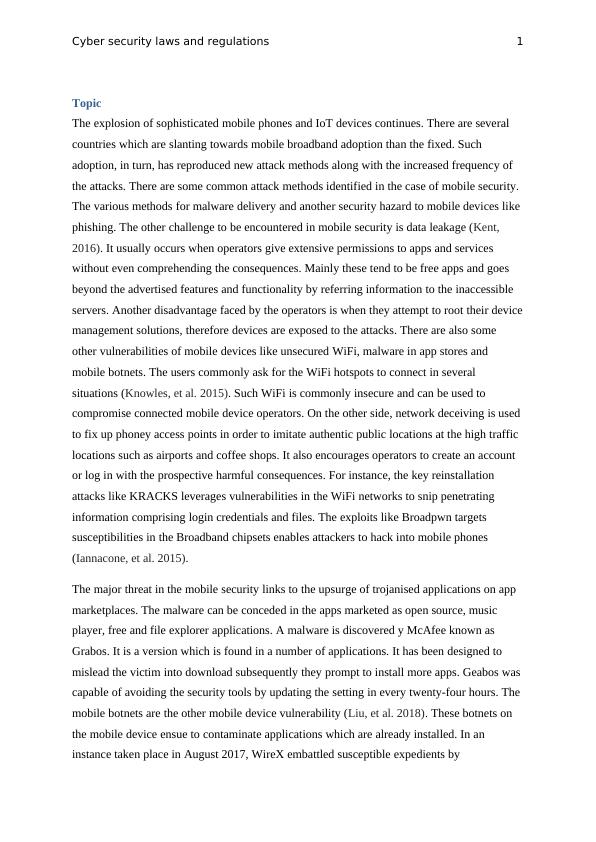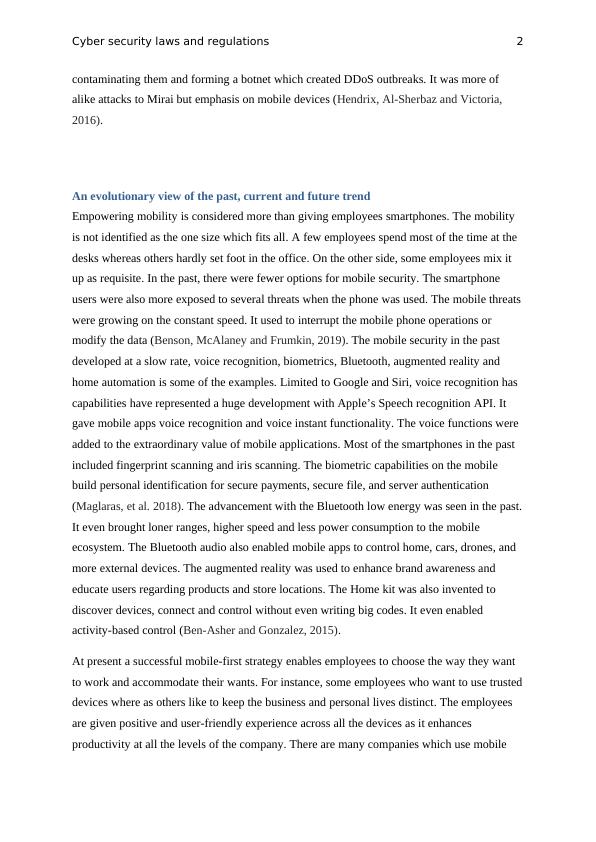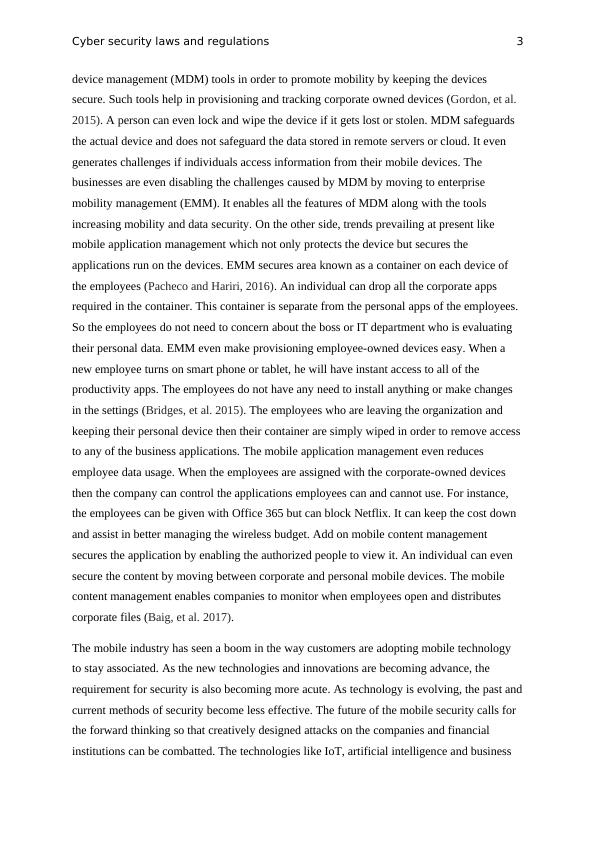Cyber Security Laws and Regulations
Explore the legal and legislative considerations related to a chosen topic/trend mentioned in the Telstra Security Report 2018.
15 Pages5469 Words290 Views
Added on 2022-12-15
About This Document
This article discusses the challenges and vulnerabilities in mobile security, such as malware delivery, data leakage, and mobile botnets. It also explores the past, current, and future trends in mobile security, including the evolution of mobile technology and the implications for businesses. Additionally, it examines the importance of legal and legislative considerations in ensuring mobile security.
Cyber Security Laws and Regulations
Explore the legal and legislative considerations related to a chosen topic/trend mentioned in the Telstra Security Report 2018.
Added on 2022-12-15
ShareRelated Documents
Cyber security
laws and
regulations
laws and
regulations

Cyber security laws and regulations 1
Topic
The explosion of sophisticated mobile phones and IoT devices continues. There are several
countries which are slanting towards mobile broadband adoption than the fixed. Such
adoption, in turn, has reproduced new attack methods along with the increased frequency of
the attacks. There are some common attack methods identified in the case of mobile security.
The various methods for malware delivery and another security hazard to mobile devices like
phishing. The other challenge to be encountered in mobile security is data leakage (Kent,
2016). It usually occurs when operators give extensive permissions to apps and services
without even comprehending the consequences. Mainly these tend to be free apps and goes
beyond the advertised features and functionality by referring information to the inaccessible
servers. Another disadvantage faced by the operators is when they attempt to root their device
management solutions, therefore devices are exposed to the attacks. There are also some
other vulnerabilities of mobile devices like unsecured WiFi, malware in app stores and
mobile botnets. The users commonly ask for the WiFi hotspots to connect in several
situations (Knowles, et al. 2015). Such WiFi is commonly insecure and can be used to
compromise connected mobile device operators. On the other side, network deceiving is used
to fix up phoney access points in order to imitate authentic public locations at the high traffic
locations such as airports and coffee shops. It also encourages operators to create an account
or log in with the prospective harmful consequences. For instance, the key reinstallation
attacks like KRACKS leverages vulnerabilities in the WiFi networks to snip penetrating
information comprising login credentials and files. The exploits like Broadpwn targets
susceptibilities in the Broadband chipsets enables attackers to hack into mobile phones
(Iannacone, et al. 2015).
The major threat in the mobile security links to the upsurge of trojanised applications on app
marketplaces. The malware can be conceded in the apps marketed as open source, music
player, free and file explorer applications. A malware is discovered y McAfee known as
Grabos. It is a version which is found in a number of applications. It has been designed to
mislead the victim into download subsequently they prompt to install more apps. Geabos was
capable of avoiding the security tools by updating the setting in every twenty-four hours. The
mobile botnets are the other mobile device vulnerability (Liu, et al. 2018). These botnets on
the mobile device ensue to contaminate applications which are already installed. In an
instance taken place in August 2017, WireX embattled susceptible expedients by
Topic
The explosion of sophisticated mobile phones and IoT devices continues. There are several
countries which are slanting towards mobile broadband adoption than the fixed. Such
adoption, in turn, has reproduced new attack methods along with the increased frequency of
the attacks. There are some common attack methods identified in the case of mobile security.
The various methods for malware delivery and another security hazard to mobile devices like
phishing. The other challenge to be encountered in mobile security is data leakage (Kent,
2016). It usually occurs when operators give extensive permissions to apps and services
without even comprehending the consequences. Mainly these tend to be free apps and goes
beyond the advertised features and functionality by referring information to the inaccessible
servers. Another disadvantage faced by the operators is when they attempt to root their device
management solutions, therefore devices are exposed to the attacks. There are also some
other vulnerabilities of mobile devices like unsecured WiFi, malware in app stores and
mobile botnets. The users commonly ask for the WiFi hotspots to connect in several
situations (Knowles, et al. 2015). Such WiFi is commonly insecure and can be used to
compromise connected mobile device operators. On the other side, network deceiving is used
to fix up phoney access points in order to imitate authentic public locations at the high traffic
locations such as airports and coffee shops. It also encourages operators to create an account
or log in with the prospective harmful consequences. For instance, the key reinstallation
attacks like KRACKS leverages vulnerabilities in the WiFi networks to snip penetrating
information comprising login credentials and files. The exploits like Broadpwn targets
susceptibilities in the Broadband chipsets enables attackers to hack into mobile phones
(Iannacone, et al. 2015).
The major threat in the mobile security links to the upsurge of trojanised applications on app
marketplaces. The malware can be conceded in the apps marketed as open source, music
player, free and file explorer applications. A malware is discovered y McAfee known as
Grabos. It is a version which is found in a number of applications. It has been designed to
mislead the victim into download subsequently they prompt to install more apps. Geabos was
capable of avoiding the security tools by updating the setting in every twenty-four hours. The
mobile botnets are the other mobile device vulnerability (Liu, et al. 2018). These botnets on
the mobile device ensue to contaminate applications which are already installed. In an
instance taken place in August 2017, WireX embattled susceptible expedients by

Cyber security laws and regulations 2
contaminating them and forming a botnet which created DDoS outbreaks. It was more of
alike attacks to Mirai but emphasis on mobile devices (Hendrix, Al-Sherbaz and Victoria,
2016).
An evolutionary view of the past, current and future trend
Empowering mobility is considered more than giving employees smartphones. The mobility
is not identified as the one size which fits all. A few employees spend most of the time at the
desks whereas others hardly set foot in the office. On the other side, some employees mix it
up as requisite. In the past, there were fewer options for mobile security. The smartphone
users were also more exposed to several threats when the phone was used. The mobile threats
were growing on the constant speed. It used to interrupt the mobile phone operations or
modify the data (Benson, McAlaney and Frumkin, 2019). The mobile security in the past
developed at a slow rate, voice recognition, biometrics, Bluetooth, augmented reality and
home automation is some of the examples. Limited to Google and Siri, voice recognition has
capabilities have represented a huge development with Apple’s Speech recognition API. It
gave mobile apps voice recognition and voice instant functionality. The voice functions were
added to the extraordinary value of mobile applications. Most of the smartphones in the past
included fingerprint scanning and iris scanning. The biometric capabilities on the mobile
build personal identification for secure payments, secure file, and server authentication
(Maglaras, et al. 2018). The advancement with the Bluetooth low energy was seen in the past.
It even brought loner ranges, higher speed and less power consumption to the mobile
ecosystem. The Bluetooth audio also enabled mobile apps to control home, cars, drones, and
more external devices. The augmented reality was used to enhance brand awareness and
educate users regarding products and store locations. The Home kit was also invented to
discover devices, connect and control without even writing big codes. It even enabled
activity-based control (Ben-Asher and Gonzalez, 2015).
At present a successful mobile-first strategy enables employees to choose the way they want
to work and accommodate their wants. For instance, some employees who want to use trusted
devices where as others like to keep the business and personal lives distinct. The employees
are given positive and user-friendly experience across all the devices as it enhances
productivity at all the levels of the company. There are many companies which use mobile
contaminating them and forming a botnet which created DDoS outbreaks. It was more of
alike attacks to Mirai but emphasis on mobile devices (Hendrix, Al-Sherbaz and Victoria,
2016).
An evolutionary view of the past, current and future trend
Empowering mobility is considered more than giving employees smartphones. The mobility
is not identified as the one size which fits all. A few employees spend most of the time at the
desks whereas others hardly set foot in the office. On the other side, some employees mix it
up as requisite. In the past, there were fewer options for mobile security. The smartphone
users were also more exposed to several threats when the phone was used. The mobile threats
were growing on the constant speed. It used to interrupt the mobile phone operations or
modify the data (Benson, McAlaney and Frumkin, 2019). The mobile security in the past
developed at a slow rate, voice recognition, biometrics, Bluetooth, augmented reality and
home automation is some of the examples. Limited to Google and Siri, voice recognition has
capabilities have represented a huge development with Apple’s Speech recognition API. It
gave mobile apps voice recognition and voice instant functionality. The voice functions were
added to the extraordinary value of mobile applications. Most of the smartphones in the past
included fingerprint scanning and iris scanning. The biometric capabilities on the mobile
build personal identification for secure payments, secure file, and server authentication
(Maglaras, et al. 2018). The advancement with the Bluetooth low energy was seen in the past.
It even brought loner ranges, higher speed and less power consumption to the mobile
ecosystem. The Bluetooth audio also enabled mobile apps to control home, cars, drones, and
more external devices. The augmented reality was used to enhance brand awareness and
educate users regarding products and store locations. The Home kit was also invented to
discover devices, connect and control without even writing big codes. It even enabled
activity-based control (Ben-Asher and Gonzalez, 2015).
At present a successful mobile-first strategy enables employees to choose the way they want
to work and accommodate their wants. For instance, some employees who want to use trusted
devices where as others like to keep the business and personal lives distinct. The employees
are given positive and user-friendly experience across all the devices as it enhances
productivity at all the levels of the company. There are many companies which use mobile

Cyber security laws and regulations 3
device management (MDM) tools in order to promote mobility by keeping the devices
secure. Such tools help in provisioning and tracking corporate owned devices (Gordon, et al.
2015). A person can even lock and wipe the device if it gets lost or stolen. MDM safeguards
the actual device and does not safeguard the data stored in remote servers or cloud. It even
generates challenges if individuals access information from their mobile devices. The
businesses are even disabling the challenges caused by MDM by moving to enterprise
mobility management (EMM). It enables all the features of MDM along with the tools
increasing mobility and data security. On the other side, trends prevailing at present like
mobile application management which not only protects the device but secures the
applications run on the devices. EMM secures area known as a container on each device of
the employees (Pacheco and Hariri, 2016). An individual can drop all the corporate apps
required in the container. This container is separate from the personal apps of the employees.
So the employees do not need to concern about the boss or IT department who is evaluating
their personal data. EMM even make provisioning employee-owned devices easy. When a
new employee turns on smart phone or tablet, he will have instant access to all of the
productivity apps. The employees do not have any need to install anything or make changes
in the settings (Bridges, et al. 2015). The employees who are leaving the organization and
keeping their personal device then their container are simply wiped in order to remove access
to any of the business applications. The mobile application management even reduces
employee data usage. When the employees are assigned with the corporate-owned devices
then the company can control the applications employees can and cannot use. For instance,
the employees can be given with Office 365 but can block Netflix. It can keep the cost down
and assist in better managing the wireless budget. Add on mobile content management
secures the application by enabling the authorized people to view it. An individual can even
secure the content by moving between corporate and personal mobile devices. The mobile
content management enables companies to monitor when employees open and distributes
corporate files (Baig, et al. 2017).
The mobile industry has seen a boom in the way customers are adopting mobile technology
to stay associated. As the new technologies and innovations are becoming advance, the
requirement for security is also becoming more acute. As technology is evolving, the past and
current methods of security become less effective. The future of the mobile security calls for
the forward thinking so that creatively designed attacks on the companies and financial
institutions can be combatted. The technologies like IoT, artificial intelligence and business
device management (MDM) tools in order to promote mobility by keeping the devices
secure. Such tools help in provisioning and tracking corporate owned devices (Gordon, et al.
2015). A person can even lock and wipe the device if it gets lost or stolen. MDM safeguards
the actual device and does not safeguard the data stored in remote servers or cloud. It even
generates challenges if individuals access information from their mobile devices. The
businesses are even disabling the challenges caused by MDM by moving to enterprise
mobility management (EMM). It enables all the features of MDM along with the tools
increasing mobility and data security. On the other side, trends prevailing at present like
mobile application management which not only protects the device but secures the
applications run on the devices. EMM secures area known as a container on each device of
the employees (Pacheco and Hariri, 2016). An individual can drop all the corporate apps
required in the container. This container is separate from the personal apps of the employees.
So the employees do not need to concern about the boss or IT department who is evaluating
their personal data. EMM even make provisioning employee-owned devices easy. When a
new employee turns on smart phone or tablet, he will have instant access to all of the
productivity apps. The employees do not have any need to install anything or make changes
in the settings (Bridges, et al. 2015). The employees who are leaving the organization and
keeping their personal device then their container are simply wiped in order to remove access
to any of the business applications. The mobile application management even reduces
employee data usage. When the employees are assigned with the corporate-owned devices
then the company can control the applications employees can and cannot use. For instance,
the employees can be given with Office 365 but can block Netflix. It can keep the cost down
and assist in better managing the wireless budget. Add on mobile content management
secures the application by enabling the authorized people to view it. An individual can even
secure the content by moving between corporate and personal mobile devices. The mobile
content management enables companies to monitor when employees open and distributes
corporate files (Baig, et al. 2017).
The mobile industry has seen a boom in the way customers are adopting mobile technology
to stay associated. As the new technologies and innovations are becoming advance, the
requirement for security is also becoming more acute. As technology is evolving, the past and
current methods of security become less effective. The future of the mobile security calls for
the forward thinking so that creatively designed attacks on the companies and financial
institutions can be combatted. The technologies like IoT, artificial intelligence and business

End of preview
Want to access all the pages? Upload your documents or become a member.
Related Documents
The Assignment on Information Securitylg...
|12
|832
|36
Method to Detect and Mitigate Datalg...
|13
|2575
|61
Mobile Application Security: Malware Threats and Defenseslg...
|6
|1508
|435
(Solved) Information Security: Assignmentlg...
|28
|7728
|183
Mobile Device Security NAME OF THE STUDENT NAME OF THElg...
|9
|476
|39
Sample Assignment on Cyber Securitylg...
|9
|2344
|38
